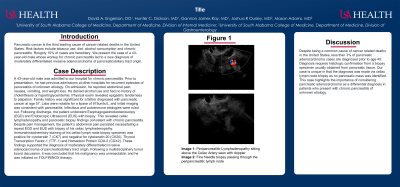Sunday Poster Session
Category: Biliary/Pancreas
P0085 - Pancreatic Adenocarcinoma Diagnosed in a Young Adult Male With Chronic Pancreatitis
Sunday, October 27, 2024
3:30 PM - 7:00 PM ET
Location: Exhibit Hall E

Has Audio
- DE
David Engerson, MD
University of South Alabama
Mobile, AL
Presenting Author(s)
David Engerson, MD1, Hunter Chance Dickson, DO2, Gannon J. Ray, MD3, Robert Ousley, MD1, Mason G. Adams, MD3
1University of South Alabama, Mobile, AL; 2USA Health, University of South Alabama, Mobile, AL; 3University of South Alabama College of Medicine, Mobile, AL
Introduction: Pancreatic cancer is the third leading cause of cancer-related deaths in the United States. Risk factors include tobacco use, diet, alcohol consumption and chronic pancreatitis. Roughly 10% of cases are hereditary. We present the case of a 43-year-old male whose workup for chronic pancreatitis led to a new diagnosis of moderately differentiated invasive adenocarcinoma of pancreaticobiliary tract origin.
Case Description/Methods: A 43-year-old male was admitted to our hospital for chronic pancreatitis. Prior to presentation, he had previous admissions at other hospitals for recurrent episodes of pancreatitis of unknown etiology. On admission, he reported abdominal pain, nausea, vomiting, and weight loss. He denied alcohol use and had no history of cholelithiasis or hypertriglyceridemia. Physical exam revealed epigastric tenderness to palpation. Family history was significant for a father diagnosed with pancreatic cancer at age 57. Labs were notable for a lipase of 975units/L, and initial imaging was consistent with pancreatitis. Infectious and autoimmune etiologies were ruled out. Following discharge, the patient underwent Esophagogastroduodenoscopy (EGD) and Endoscopic Ultrasound (EUS) with biopsy. This revealed celiac lymphadenopathy and pancreatic biopsy findings consistent with chronic pancreatitis. Despite pain management, the patient’s abdominal pain persisted necessitating a repeat EGD and EUS with biopsy of his celiac lymphadenopathy. Immunohistochemistry staining of his celiac lymph node biopsy specimen was positive for cytokeratin 7 (CK7) and negative for cytokeratin 20 (CK20), Thyroid Transcription Factor-1 (TTF-1) and Homeobox Protein CDX-2 (CDX2). These findings supported the diagnosis of moderately differentiated invasive adenocarcinoma of pancreaticobiliary tract origin. Following a multidisciplinary tumor board discussion, it was concluded that his malignancy was unresectable, and he was initiated on FOLFIRINOX therapy.
Discussion: Despite being a common cause of cancer related deaths in the United States, less than 3% of pancreatic adenocarcinoma cases are diagnosed prior to age 45. Diagnosis requires histologic confirmation from a biopsy specimen usually obtained from pancreatic tissue. Our case is unique in that the diagnosis was made via celiac lymph node biopsy as no pancreatic mass was identified. This case highlights the importance of considering pancreatic adenocarcinoma as a differential diagnosis in patients who present with chronic pancreatitis of unknown etiology.
Disclosures:
David Engerson, MD1, Hunter Chance Dickson, DO2, Gannon J. Ray, MD3, Robert Ousley, MD1, Mason G. Adams, MD3. P0085 - Pancreatic Adenocarcinoma Diagnosed in a Young Adult Male With Chronic Pancreatitis, ACG 2024 Annual Scientific Meeting Abstracts. Philadelphia, PA: American College of Gastroenterology.
1University of South Alabama, Mobile, AL; 2USA Health, University of South Alabama, Mobile, AL; 3University of South Alabama College of Medicine, Mobile, AL
Introduction: Pancreatic cancer is the third leading cause of cancer-related deaths in the United States. Risk factors include tobacco use, diet, alcohol consumption and chronic pancreatitis. Roughly 10% of cases are hereditary. We present the case of a 43-year-old male whose workup for chronic pancreatitis led to a new diagnosis of moderately differentiated invasive adenocarcinoma of pancreaticobiliary tract origin.
Case Description/Methods: A 43-year-old male was admitted to our hospital for chronic pancreatitis. Prior to presentation, he had previous admissions at other hospitals for recurrent episodes of pancreatitis of unknown etiology. On admission, he reported abdominal pain, nausea, vomiting, and weight loss. He denied alcohol use and had no history of cholelithiasis or hypertriglyceridemia. Physical exam revealed epigastric tenderness to palpation. Family history was significant for a father diagnosed with pancreatic cancer at age 57. Labs were notable for a lipase of 975units/L, and initial imaging was consistent with pancreatitis. Infectious and autoimmune etiologies were ruled out. Following discharge, the patient underwent Esophagogastroduodenoscopy (EGD) and Endoscopic Ultrasound (EUS) with biopsy. This revealed celiac lymphadenopathy and pancreatic biopsy findings consistent with chronic pancreatitis. Despite pain management, the patient’s abdominal pain persisted necessitating a repeat EGD and EUS with biopsy of his celiac lymphadenopathy. Immunohistochemistry staining of his celiac lymph node biopsy specimen was positive for cytokeratin 7 (CK7) and negative for cytokeratin 20 (CK20), Thyroid Transcription Factor-1 (TTF-1) and Homeobox Protein CDX-2 (CDX2). These findings supported the diagnosis of moderately differentiated invasive adenocarcinoma of pancreaticobiliary tract origin. Following a multidisciplinary tumor board discussion, it was concluded that his malignancy was unresectable, and he was initiated on FOLFIRINOX therapy.
Discussion: Despite being a common cause of cancer related deaths in the United States, less than 3% of pancreatic adenocarcinoma cases are diagnosed prior to age 45. Diagnosis requires histologic confirmation from a biopsy specimen usually obtained from pancreatic tissue. Our case is unique in that the diagnosis was made via celiac lymph node biopsy as no pancreatic mass was identified. This case highlights the importance of considering pancreatic adenocarcinoma as a differential diagnosis in patients who present with chronic pancreatitis of unknown etiology.
Disclosures:
David Engerson indicated no relevant financial relationships.
Hunter Chance Dickson indicated no relevant financial relationships.
Gannon Ray indicated no relevant financial relationships.
Robert Ousley indicated no relevant financial relationships.
Mason Adams indicated no relevant financial relationships.
David Engerson, MD1, Hunter Chance Dickson, DO2, Gannon J. Ray, MD3, Robert Ousley, MD1, Mason G. Adams, MD3. P0085 - Pancreatic Adenocarcinoma Diagnosed in a Young Adult Male With Chronic Pancreatitis, ACG 2024 Annual Scientific Meeting Abstracts. Philadelphia, PA: American College of Gastroenterology.
